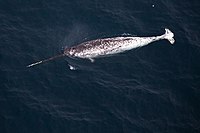
Photo from wikipedia
Acoustic data from the Canada Basin Acoustic Propagation Experiment are discussed. These recordings were obtained under seasonally varying sea ice to the north of Alaska during a period of 154… Click to show full abstract
Acoustic data from the Canada Basin Acoustic Propagation Experiment are discussed. These recordings were obtained under seasonally varying sea ice to the north of Alaska during a period of 154 days. They contain signals from sources that were deployed at ranges of 17.5, 29.6, and 237.8 km and ambient sounds from marine mammals and ice-related events. After the area was covered with ice, the amplitude of receptions from the most distant source gradually decreased as scattering features on the underside of the ice developed during fracturing, drifting, ridging, and rafting events. Improvements are presented for an Arctic acoustic model that is based on the parabolic equation method, and the approach is applied to a problem in which variable ice thickness acts as a loss mechanism by scattering energy out of the waveguide. Some of the recordings have a harmonic signature that is believed to be associated with the resonances of ice floes rubbing together, but variations in the harmonics over short time scales cannot be explained in terms of the resonances of an isolated floe. This behavior may be related to the coupling of vibrations at contact points that vary during the relative motions of floes.
Journal Title: Scientific Reports
Year Published: 2019
Link to full text (if available)
Share on Social Media: Sign Up to like & get
recommendations!